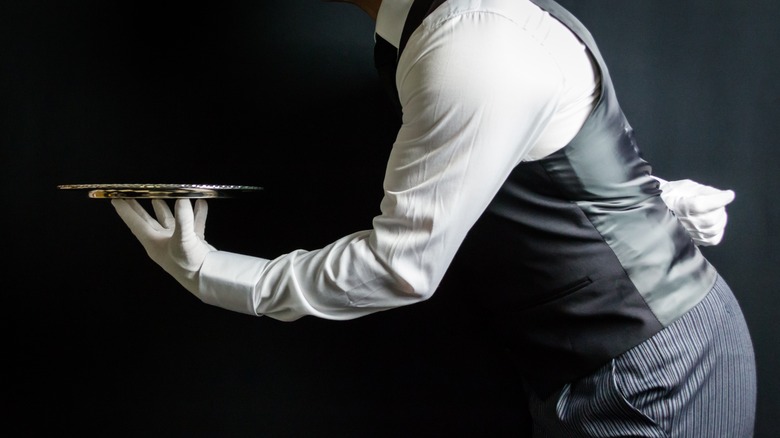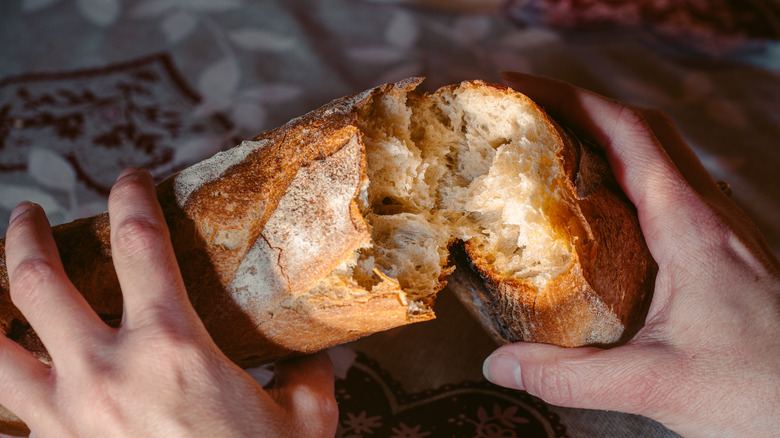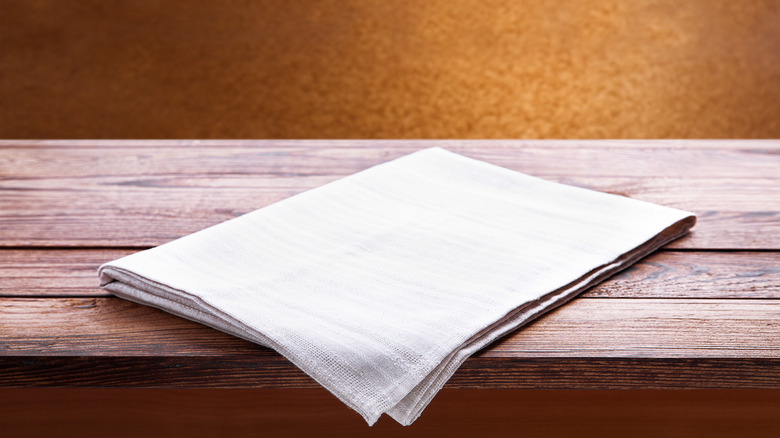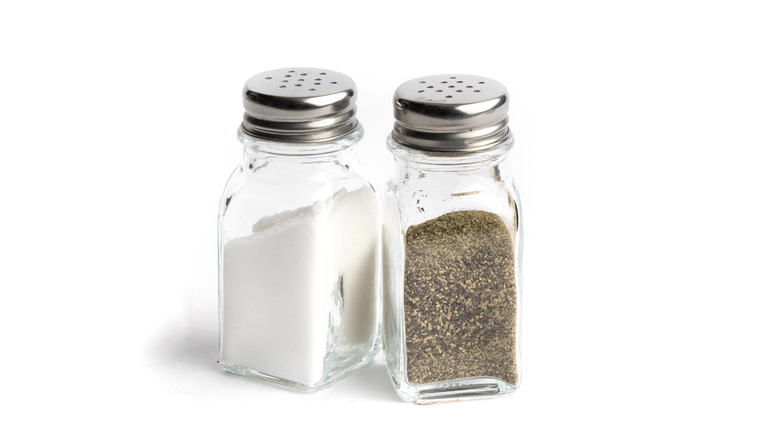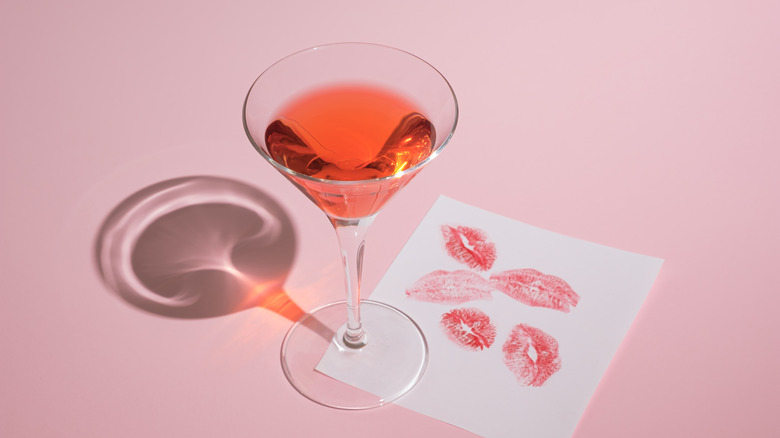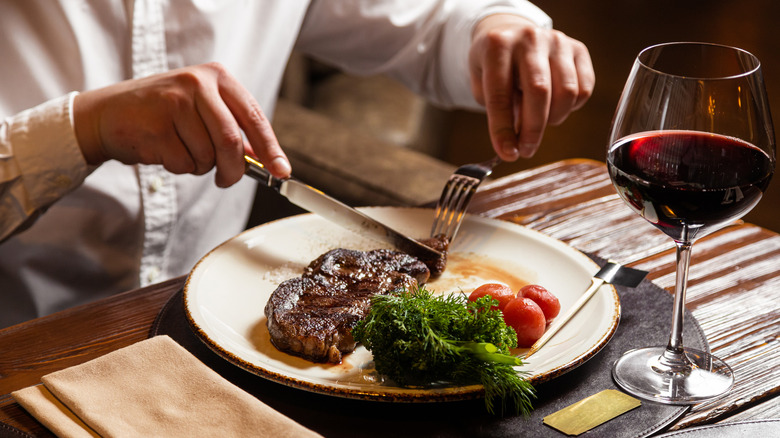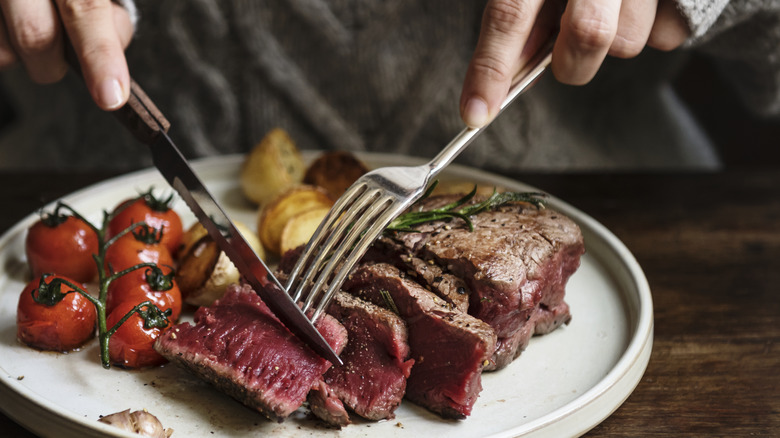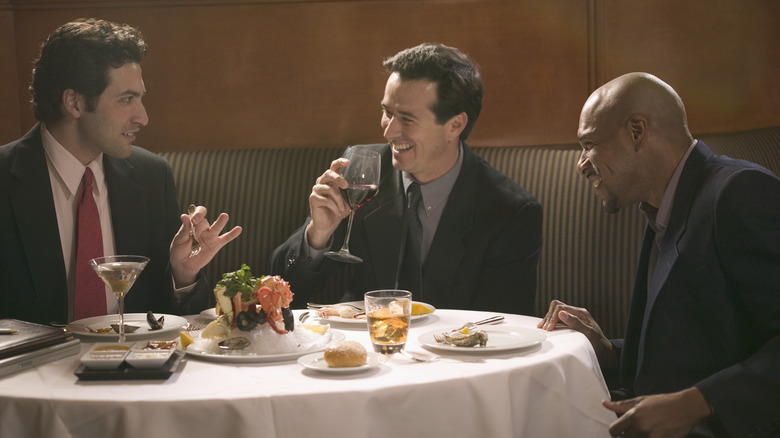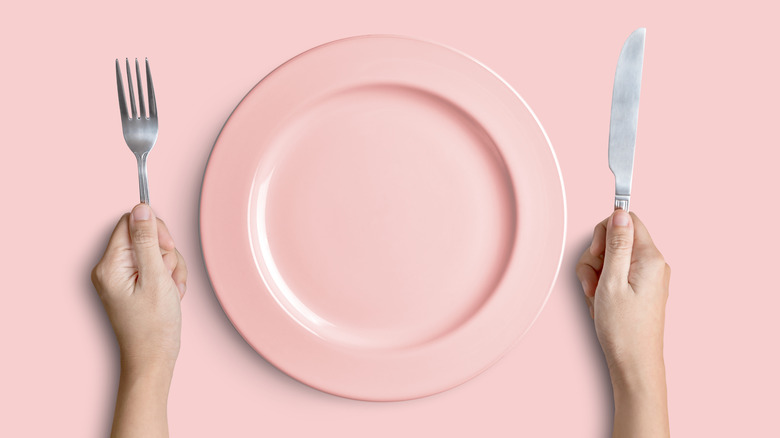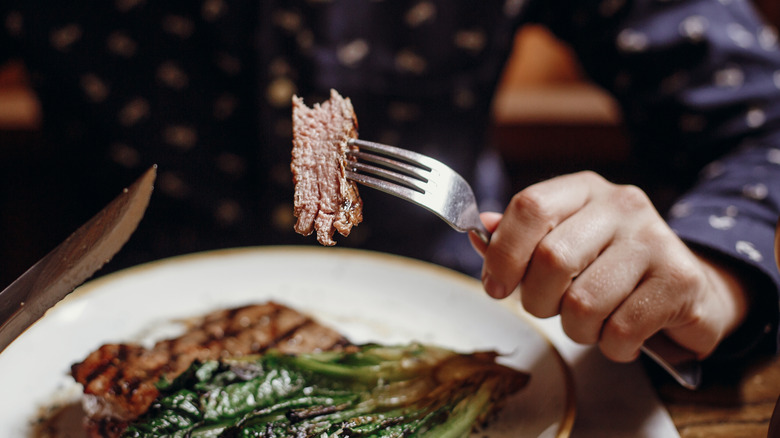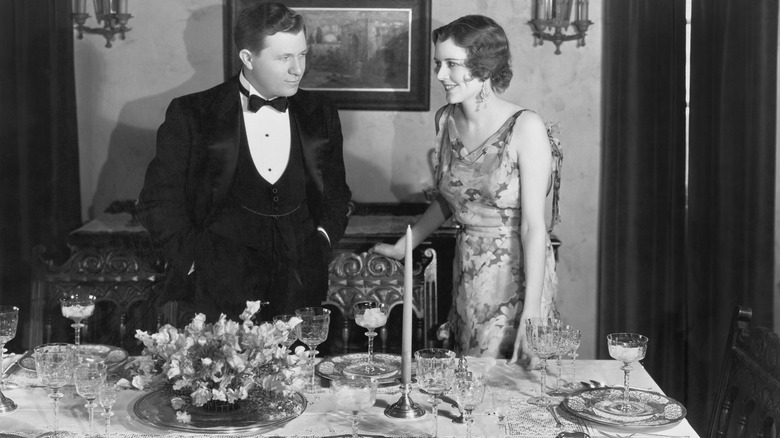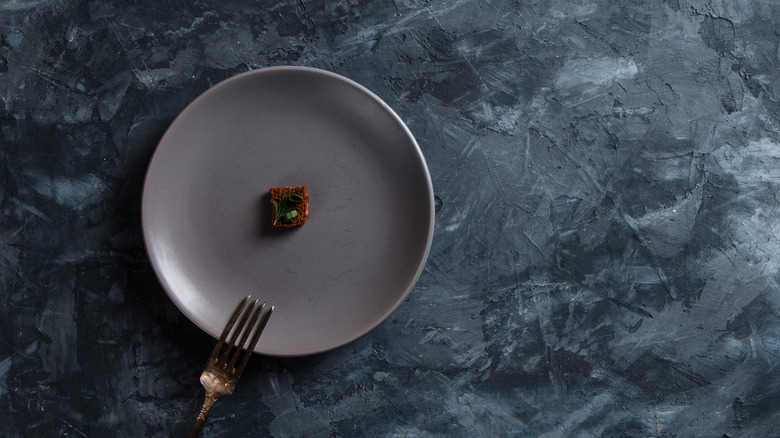14 Fine Dining Rules That Make Absolutely No Sense And Should Be Broken
In the world of fine dining, rules of etiquette are strict and plentiful. And while there are secrets fine dining restaurants don't want you to know, there are also many unwritten rules that they expect everyone to know as if by osmosis. Some of these rules make perfect sense. For example, chewing with your mouth closed is something many people learn to do as children and applies to all dining situations. Similarly, it's logical to wait to season your food until after you've tasted it.
Alongside these common-sense rules, however, there are a host of downright unreasonable ones that people continue to employ and expect others to do the same. Why, for example, is cutting bread with a knife offensive to the laws of etiquette when tearing it into small pieces with your fingers is not?
Even fine-dining traditionalists who believe in upholding strict codes of conduct should consider excising some of these practices from their meals. Fine dining is a serious business and art form, and it deserves to be approached with respect and formality. But some rules that people are expected to follow simply make no sense.
1. Tear your bread instead of cutting it
In a viral TikTok video from 2022, Dr. Clinton Lee, executive director of the Asia Pacific Wine and Spirit Institute, informed viewers that they had been eating bread wrong their entire lives. In fine dining, it turns out, bread must never be cut with a knife or picked up as a slice. Instead, it should be torn into bite-sized pieces that are buttered individually as you eat. This rule of etiquette is a long-held tradition in fine dining and French culture, with origins rooted in the Bible. The term "breaking bread" refers to the practice of sharing a meal. Jesus is said to have distributed bread among his disciples in this manner, demonstrating the importance of generosity and making sure no one is left with an empty stomach.
Breaking bread has become a well-known phrase that describes sharing and coming together despite differences. In fine dining, however, it no longer makes sense to apply the words literally. No one is sharing the bread on their plate in a fancy restaurant because everyone receives their own abundant portions. The origins of the rule are even less applicable to the current day when considering that yet another tenet of fine dining dictates that you must not share food with your companions once the meal has begun. Given these factors, tearing bread is not only impractical compared to cutting it, but also incompatible with other fine dining rules.
2. Your napkin should be folded in half with the fold facing you
One of the cardinal rules of fine dining is that you should never make a mess. Unfortunately, eating can be a grubby business, and napkins are the first line of defense. A problem arises, however, when the napkin itself is soiled, at least according to generations of questionable etiquette. According to tradition, visible stains can be avoided by folding your napkin in half with the crease facing your body. This way, you can dab your mouth with the inside of the napkin and safely fold it again so that none of your dinner companions will be afflicted with the sight of smudges.
While this trick may delight some stain-averse diners, there is no avoiding the fact that eating is an inherently messy business, and pretending otherwise is a losing battle. As long as you're using your napkin in the first place, you shouldn't be shamed for showing a few stains on the one part of the table setting designed for dabbing away messes. The only person who should be shamed in this scenario is the one peering into their neighbor's lap to look for soiled napkins.
3. Always pass the salt and pepper shakers together
Some fine dining rules are simply baffling. One of the least logical examples is the insistence that the salt and pepper shakers be passed together, no matter what. If your dining companion asks for the salt and you pass them just the salt, you have broken an ironclad rule of fine dining and demonstrated your lack of refinement.
Etiquette experts like to employ the analogy that the salt and pepper are married, as if married couples were never more than a centimeter apart. But no matter how quaint the description, it still doesn't make sense. If your dining companion requests the salt, you should not be condemned for passing them what they want. If the next person wants both shakers, passing them from different sides of the table isn't going to cause much of a disturbance, and in a setting where courtesy is everything, listening and responding to your companions' needs should be the number one priority, not keeping the salt and pepper paired with each other at all costs.
4. Never blow on food, even when it's too hot to eat
Bad news for anyone who dislikes burning their tongue: blowing on hot food is on par with spitting on your dinner companion's plate as far as fine dining rules are concerned. According to custom, you should simply wait for your food to cool if it's too hot to eat. This is a baffling rule for anyone who's experienced a multi-course meal in which plates are presented and whisked away at intervals you do not control. When you have a limited time to eat your food, every moment counts. For slow eaters, blowing on their food might be the difference between finishing the soup and only managing a few spoonfuls.
No one wants to spread germs at a fancy restaurant (or anywhere else, presumably), but there's a difference between lightly blowing on a spoonful of hot soup that only you will consume and blowing out candles on a birthday cake that will be shared with everyone. As long as you do it quietly and at a safe distance from your dining companions' food, there is no reason for anyone to take offense.
5. Always drink from the same part of the glass for every sip
Fine dining rules are all about subtlety and cleanliness, right down to the rim of your glass. There is no way to avoid mouth marks on your glass, so people who follow table etiquette, including the British royal family, minimize the issue by choosing one section of the rim to sip from throughout the meal. This limits mouth marks to one location, leaving the rest of your glass clear and shiny.
This trick might be helpful for the kitchen staff who must contend with cleaning waxy lipstick marks off of the glassware, but aside from their travails, drinking from the exact same section of the rim is a lot to ask. Going cross-eyed every time you take a delicate sip of Bordeaux or tactfully swig some water is a level of complication that you don't need when you're trying to enjoy a luxurious meal. If you're already demonstrating impeccable conversational skills and employing the proper cutlery for each course, a few marks on your glass won't scandalize your fellow diners. You can always just blot your lipstick with your napkin to minimize the damage to your glass.
6. Your plate has strictly designated sections and the invisible lines must not be crossed
Given how strict the rules of fine dining are, it will likely come as no surprise that they extend to the geography of your plate. According to the rules of etiquette, your plate has invisible boundaries that designate the purpose of each area. The upper left section of your plate is reserved for discards such as bones and squeezed lemon rinds. The bottom right of your plate is reserved for butter and sauce. Bread must remain on the bread plate at all times, to the left of your main plate, unless you are delivering a small, shredded piece to your mouth. The final rule of plate geography is that you must not dirty the rim because it makes you look messy and might soil your servers' hands when they clear the table. You may be wondering where you're supposed to eat in this configuration. The answer is the bottom left.
The impracticality of these rules is evident to anyone who has been served food on a minuscule plate while dining at a fine restaurant. Unless you have a platter in front of you, sectioning your dish into multiple zones makes for a stressful and cramped meal. As long as your plate is tidy and you aren't allowing scraps or sauce to fall onto the tablecloth, you should be allowed to divide and mix the contents of your plate as you wish.
7. Do not say bon appétit, especially at a French restaurant
One of the most disappointing and surprising rules of fine dining is that you should never say "bon appétit," especially at a French restaurant. The literal translation, "good appetite," alludes to the inner workings of your stomach, which, according to etiquette experts is crude and out of place in a fine dining setting. In France, the phrase has been all but banned from fine dining since the 19th century when the mere mention of food during a meal was considered rude. During that time, only the most intellectual subjects were deemed polite.
Phrases take on new meanings with time, however, and since the 1800s, "bon appétit" has become a catch-all term for good wishes on the meal. A phrase like "Bon appétit" is a friendly message that carries the formality and chicness of the French language. Throwing cold water on the term simply because it was out of fashion during a specific moment in French history seems like an overreaction.
8. Your fork tines should be pointing downward at all times
Some fine dining rules seem specifically designed to make eating harder. Take, for instance, the tenet that fork tines point downward at all times. This forces diners to spear their food rather than scoop it, which may look clean and elegant by some standards but is highly inconvenient for anyone hoping to satiate their hunger. Spearing one pea at a time is a tedious business and will likely lead to grumpy eaters.
This is not an issue with foods like meat or broccoli which can easily be speared and delivered to your mouth without incident, but if you're trying to eat mashed potatoes or rice, you may as well have no cutlery at all. Fine dining rules require commitment and attention to detail, but when they prevent you from enjoying the food at the center of the proceedings, they should be left in the past. Forks can be used to eat an array of foods, and their versatility should be celebrated, not constrained.
9. Keep your left hand in your lap when you're not using it
One of the biggest pitfalls in fine dining is that different countries have different etiquette rules, and even countries that use the same style vary in the specifics. Many European countries, including the U.K., favor the Continental style of dining, but while Germany, Spain, and France insist on having both wrists on the table throughout the meal, the British royal family requires people to eat with their left hands in their laps unless they are using a knife and fork. Americans usually observe the latter method, keeping one hand in their laps throughout the meal like the British.
The practice of keeping both wrists above the table can be traced back, like so many rules of etiquette, to a monarch's fear of being poisoned. Louis XIV of France wanted to avoid being murdered by his dinner guests, so he insisted everyone keep both hands visible.
These days, most patrons of fine dining establishments aren't actively avoiding assassination, so keeping both hands on the table isn't a matter of life or death. There's also no reason why people should be bound to keeping one hand in their lap. Given how muddled the rules are, it seems logical that everyone adheres to their own preferences rather than trying to remember which rules apply to which setting.
10. The knife stays in your right hand and the fork in the left
The saying goes that you must learn the rules before you can break them. In the case of etiquette, however, most people who break the rules are blissfully unaware of their transgressions. For Americans, this is especially true with cutlery. In the U.K. and most of Europe, knives have always been held in the right hand while the fork stays in the left. The practice supposedly dates back to the time when men carried swords in their right hand, but even then it must have been a hassle. The method allows for easy cutting if you're right-handed, but also requires that you successfully spear your food with a downward-facing fork in your left hand. For those who are not ambidextrous, this is no easy task and may lead to the worst possible outcome: stray food.
Americans have solved the problem by using the zig-zag method — switching back and forth between the knife and fork so that they're always using their dominant hand depending on whether they are cutting or eating. It is such a practical workaround that British people have started to adopt the American method, sacrificing their pride for the sake of a relaxed meal. As this shift illustrates, everyone is ready for this rule to retire, even the culture that invented it.
11. Only cut one bite at a time
Another rule of fine dining is that you must eat at a similar rate to your companions. You can slow yourself down by cutting one bite of food at a time. In the American style of dining, this entails switching your fork from your right hand to your left, cutting a bite-sized piece with the knife in your right hand, returning the knife to the upper rim of your plate, switching your fork back to your right hand, eating the piece you've just cut, and starting the process again.
If you're using the European style of keeping the knife in your right hand and the fork in your left, you won't have to switch utensils between hands, but you will have to use your non-dominant hand to hold your fork and alternate between brief intervals of chewing and cutting.
Eating at a similar pace to your dining companions makes sense, but there are other ways to achieve this than by juggling your utensils for the duration of the meal. It's much easier to cut several slices of your food at the same time before eating, especially since you'll be able to set your knife aside and only have to worry about fork etiquette. If you need to slow down to keep pace with your companions, you can simply chew more slowly or focus on the conversation.
12. Clinking glasses is a no-go, even when toasting
Clinking glasses is one of the most enjoyable and widely practiced ways to celebrate a special occasion, but according to the laws of fine dining, it's poor form. This is due to the delicate, breakable nature of glassware.
There are multiple theories about why clinking glasses arose. One story goes that in medieval times when kings were constantly trying to poison each other, the hosting monarch would prove his good intentions by sipping his guest's wine. If the guest trusted him, he would simply clink his companion's glass instead of exchanging his drink. Another theory involves warding off bad spirits, and a third, which is less exciting but more applicable to the present day, is the addition of the fifth sense (touch) to the ceremonial act of drinking.
Regardless of why clinking glasses became a tradition, it remains a heartwarming expression of togetherness and celebration that rarely results in broken glassware. The only occasion when it makes sense to refrain from clinking is when you are toasting with beer in Hungary, where the practice is frowned upon for a good reason. The story goes that during the country's unsuccessful 1848 uprising against the Habsburgs, the Austrians celebrated their victory by clinking glasses of beer while their troops slaughtered the Hungarians. Outside of beer in Hungary, though, everyone should feel free to celebrate with a good old-fashioned clink.
13. Men should stand when a woman enters or leaves the room
Some dining etiquette rules are relics of the past that no longer apply to modern social dynamics. It used to be standard practice for men to stand whenever a woman entered or left the room, and it is still encouraged in fine dining settings. The idea behind it makes perfect sense. Standing for your dining companion is a welcoming gesture that makes the person feel included in the group without having to walk around the table shaking hands with everyone. These days, however, the formality of standing when a woman enters the room has been modified, especially in business settings, to include all genders. It makes more sense for women to stand to greet their fellow diners (male and female) alongside the men rather than remaining seated and risking being perceived as discourteous.
Keeping this practice intact and gender-neutral makes the most sense in our modern world, but there should be a limit to how frequently people are expected to rise from their chairs. Standing when a person joins the group for the first time is courteous and friendly, but doing so every time they step away for a brief bathroom break is likely to be more embarrassing for them than respectful. Etiquette dictates that restroom breaks be taken with as little acknowledgment as possible, and to have the whole table stand every time a person tries to subtly excuse themselves for this purpose is counterproductive.
14. Make sure to leave one bite of food on your plate
Despite all the table manners expected at a fine dining restaurant, the food is the focus. Unfortunately, however, there is one final rule that robs you of one aspect of the meal: the last bite. According to fine dining etiquette, you should leave one bit of food on your plate at the end of the meal. This signifies to the chef and host that you have enjoyed your food but have not been left hungry. No one wants to offend the restaurant or appear gluttonous, but in a setting where the portions are often vanishingly small and the food is made with painstaking artistry and expertise, leaving any amount of food on your plate feels wasteful and even a little disrespectful.
There are other ways to communicate your satisfaction with the meal. You can simply say it to your fellow diners or ask the server to relay your gratitude and compliments to the chef. Symbolic gestures of restraint and respect have their place in fine dining, but when it comes to the food on your plate, you should be free to enjoy every last morsel.
